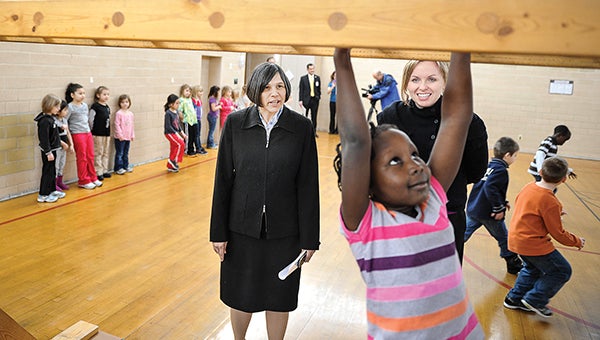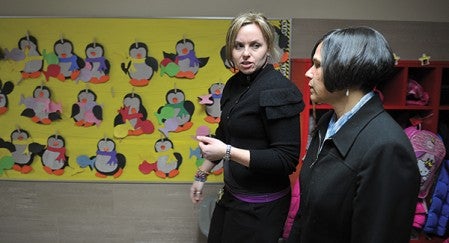Education head visits district, checks out Woodson
Published 11:22 am Friday, February 22, 2013

Department of Education Commissioner Brenda Cassellius, left, with Woodson Kindergarten principal Jessica Cabeen watch Oduru Awow during Boost Up Thursday afternoon in the school’s gym. — Eric Johnson/photodesk@austindailyherald.com
Brenda Cassellius stepped into the Sumner Elementary classroom to introduce herself.
“My boss runs the state of Minnesota,” she told the class, then asked if anyone knew that person’s name. Students called out guesses like “Barack Obama” and “Bill Clinton” before Gov. Mark Dayton’s name was revealed.

Commissioner Brenda Cassellius of the Department of Education looks over the shoulders of Woodson Kindergarten students using iPads.
Cassellius, the state education commissioner, visited Sumner as part of a tour of Austin Public Schools Thursday afternoon.The Austin tour follows Dayton’s proposal last week to budget $40 million to support all-day kindergarten opportunities statewide.
“Why I am here is because of your focus on all-day kindergarten,” she said.
Dayton is looking to boosting preschool and kindergarten programs to cut down Minnesota’s achievement gap, which is one of the worst in the nation, Cassellius said.
She included a visit to Sumner because the state Department of Education named it a Celebration School in January.
Sumner Principal Sheila Berger led the tour along with Superintendent David Krenz, Educational Services Director John Alberts and the school board’s Dick Leas. Cassellius listened with enthusiasm, asking follow-up questions about programming and praising features like the auditorium and the library.
“I always say the library ought to be the hub of the school,” she said.
Berger explained how fifth grade would move to the new I.J. Holton Intermediate School next school year, and gave other details about the workings of the school and what a typical classroom looks like. Leas was able to relate how the building had changed since he attended decades ago.
During the tour, Cassellius stopped to ask students in classrooms and hallways about themselves and whether they liked school at Sumner.
While meeting Integration Coordinator Kristi Beckman, Cassellius said Austin’s integration revenue was not likely in danger of cuts.

Woodson Kindergarten principal Jessica Cabeen talks with Commissioner Brenda Cassellius from the Department of Education.
“I don’t think you have to be too concerned about it,” she said.
Alberts explained how the Success Coach program relies on that source of funding.
“It’s become pretty well woven into everything we do,” he said.
Cassellius later added the funding policy will be re-written to change the formula for how much money each district receives and also to introduce accountability measures to make sure it’s being used correctly. The result could end up benefiting local schools because of the concentration of students of color in Austin.
“There needs to be a different way to calculate that that’s more fair,” she said. “Your district will probably get more dollars.”
Diversity in schools is something Cassellius, a Minneapolis native, is familiar with, but she said it was more prevalent in Austin than she expected.
“As I visit Greater Minnesota, I’m amazed at how much diversity there is,” she said.
The ending of the tour included a chance for officials to express their opinions on different education initiatives in the state, both in terms of what they liked and what they wanted to see changed.
Alberts agreed with Casselius that the Multiple Measurement Rating system was a useful tool, saying it provided a rich amount of data that allowed the district to be smart about how it made improvements.
“The governor’s been pushing me on better assessments,” Cassellius said. “Your input helps.”
Austin school officials did voice criticism about teacher licensing, however, especially in regards to tests that require adeptness in fields like calculus.
“I can’t guarantee they’re licensed and ready to teach on time,” Berger said of previous struggles finding recently graduated teachers to fill positions at Sumner.
When moving onto the matter of school safety, Cassellius said it was common for schools like those in Austin to be tightening up access on entrances to the building.
“Greater Minnesota schools have been quite open, but now they’re rethinking it,” she said.
Austin schools have started retrofitting front entrances, a move that was made before the recent tragedy in Newtown, Conn., Krenz said.
Following the district tour, Cassellius pressed the importance of the state finding a fair means of meeting its revenue needs in place of relying on actions like a school shift.




